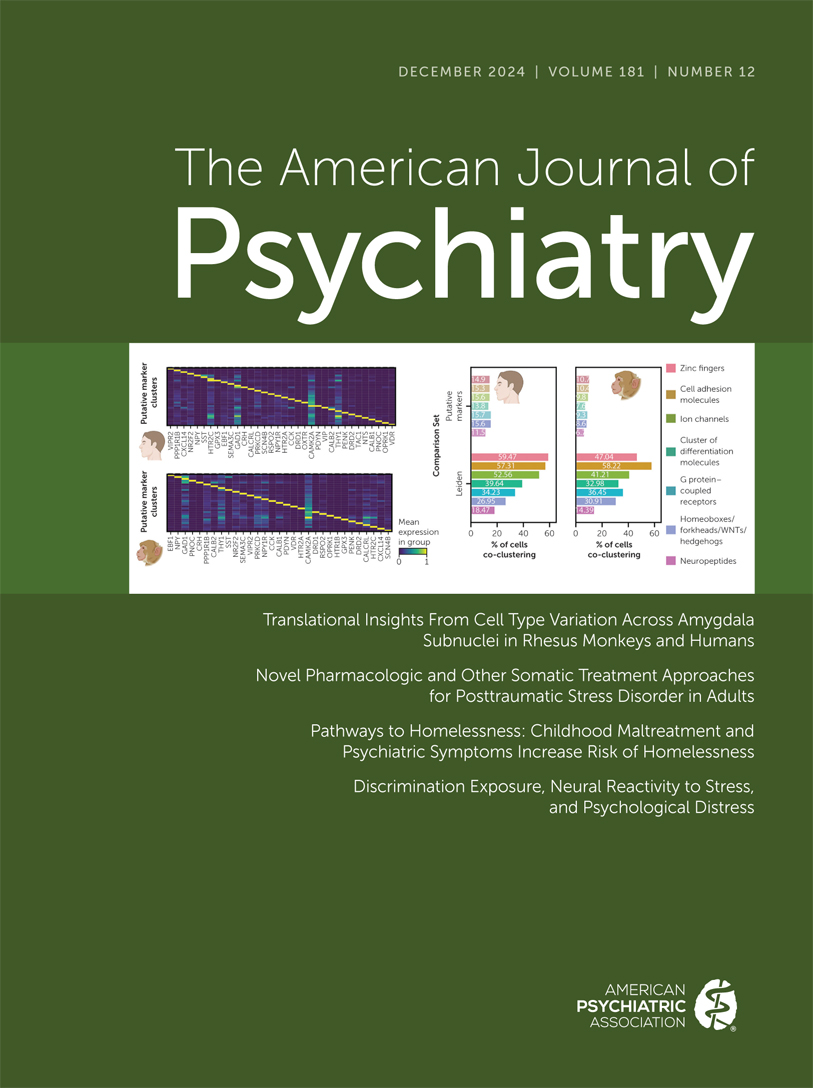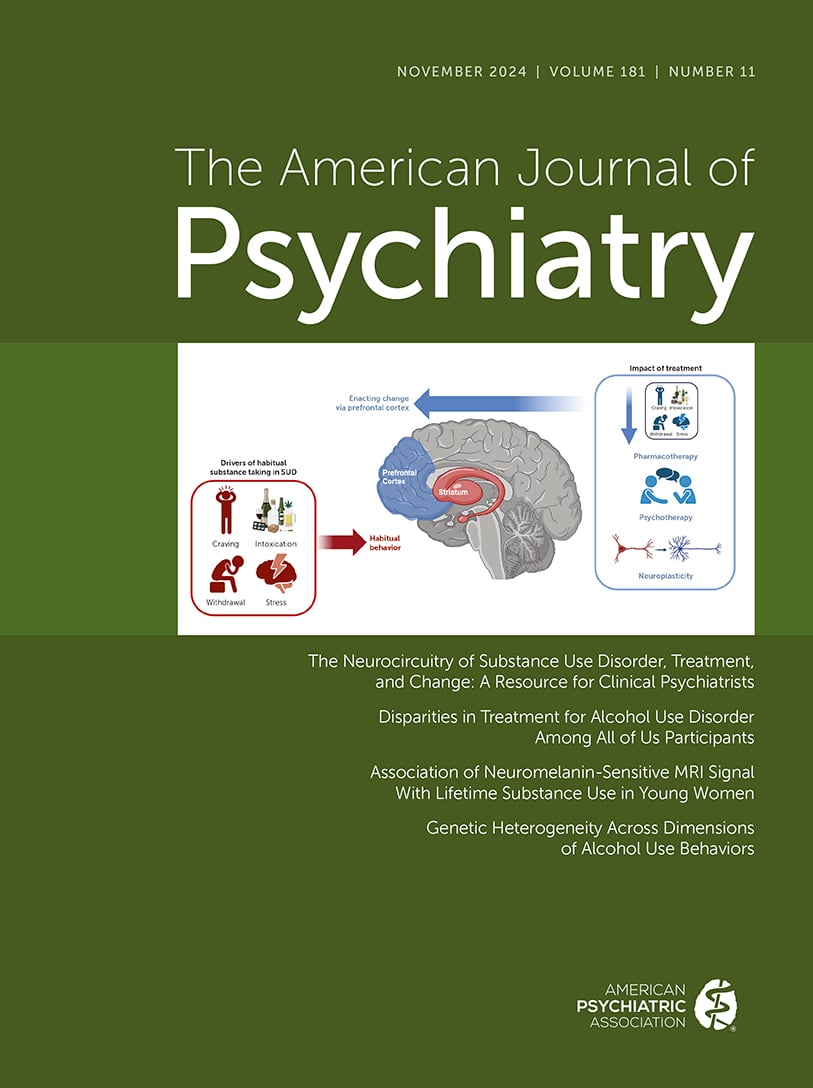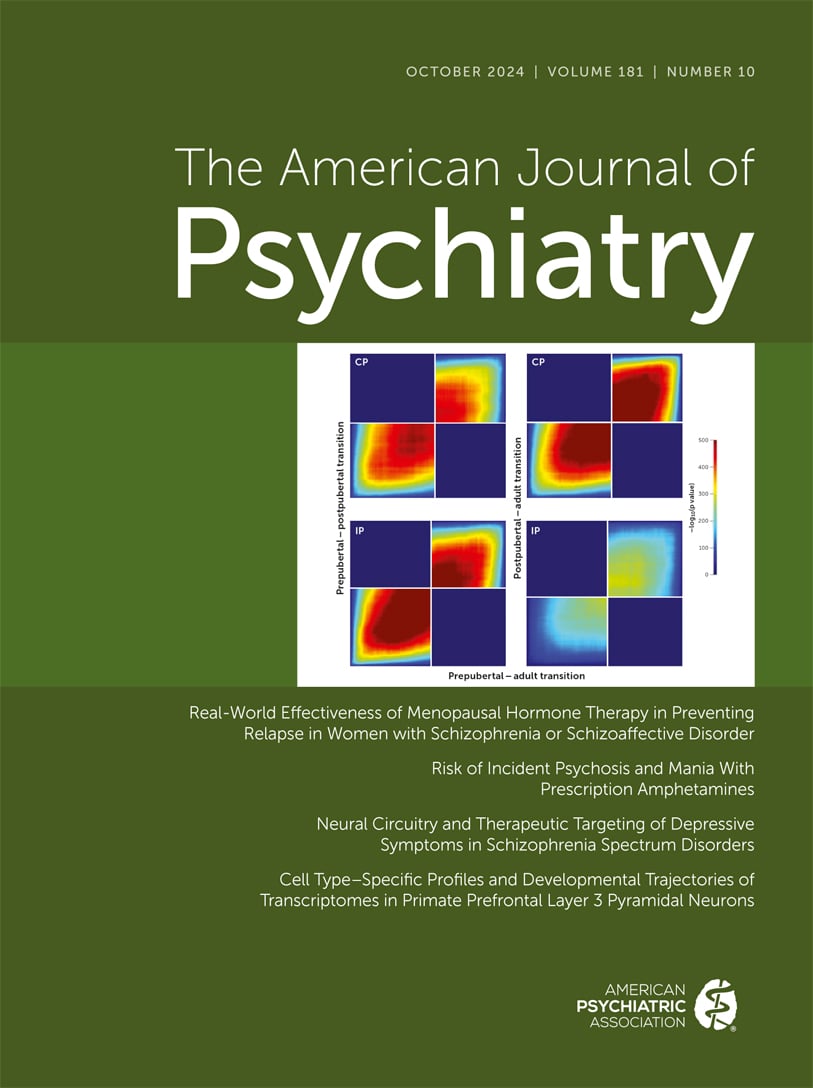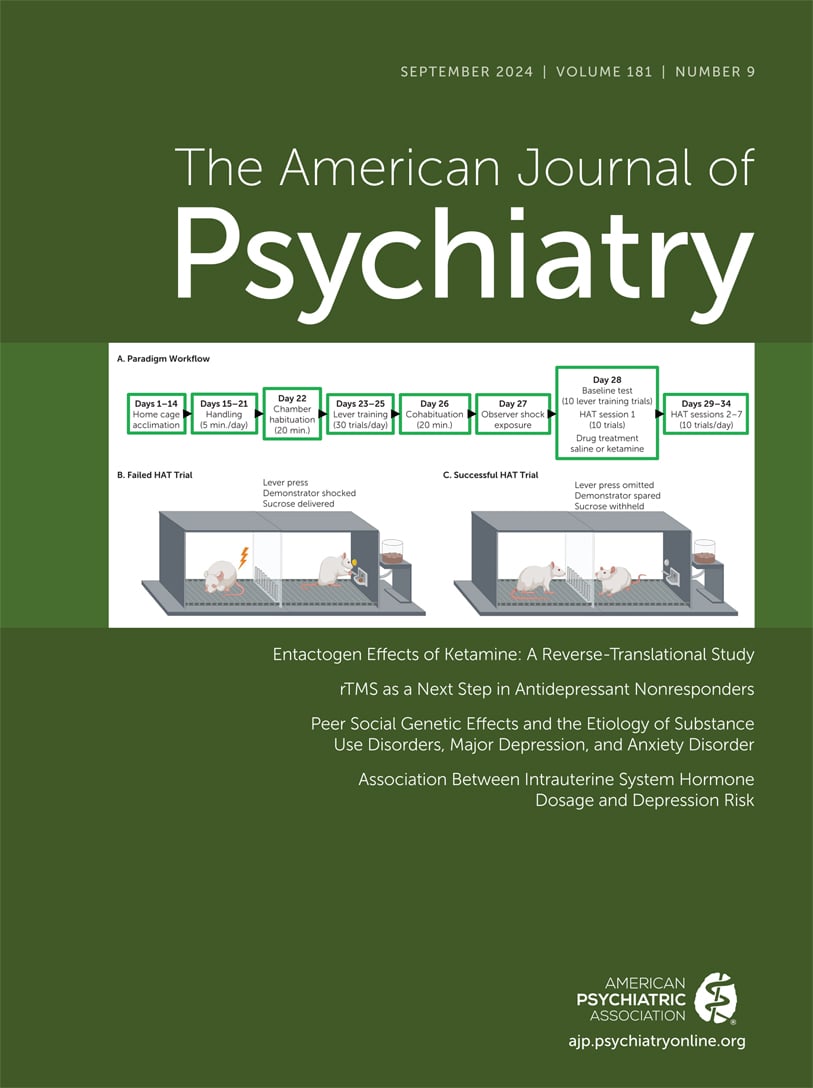American Journal of Psychiatry
- Volume 146
- Number 9
- September 1989
Article
Article
Publication date: 01 September 1989
Pages1115–1120The authors propose that oscillations of attachment in borderline personality disorder stem from a central problem with regulation of interpersonal distance. This problem derives from borderline patients' conflicts between fears of abandonment and ...
https://doi.org/10.1176/ajp.146.9.1115Publication date: 01 September 1989
Pages1121–1130The implementation of quality assurance monitoring is an important response to public demands for accountability in medicine as well as a requirement for institutional accreditation by the Joint Commission on Accreditation of Healthcare Organizations (...
https://doi.org/10.1176/ajp.146.9.1121Publication date: 01 September 1989
Pages1131–1141Psychopathology coexisting with substance abuse in adolescents is often encountered in a variety of clinical settings. Research findings suggest a major role for substance use in the etiology and prognosis of psychiatric disorders such as affective ...
https://doi.org/10.1176/ajp.146.9.1131Publication date: 01 September 1989
Pages1142–1148Managed health care, through prepaid health delivery systems and utilization review organizations, is perhaps the greatest trend in modern health care. The authors examine the remarkable growth of managed care and outline its clinical, economic, ethical, ...
https://doi.org/10.1176/ajp.146.9.1142Publication date: 01 September 1989
Pages1149–1154The authors assessed cyclothymic mood swings and psychosocial adjustment in 38 unipolar depressed, 27 bipolar, 35 schizophrenic, and 27 other psychiatric patients 4 years after hospital discharge and in 153 normal control subjects. The patients were ...
https://doi.org/10.1176/ajp.146.9.1149Publication date: 01 September 1989
Pages1155–1160Fifty-eight subjects self-referred for premenstrual difficulty were evaluated for late luteal phase dysphoric disorder through a spectral analysis technique applied to prospective symptom ratings. Data from the Schedule for Affective Disorders and ...
https://doi.org/10.1176/ajp.146.9.1155Publication date: 01 September 1989
Pages1161–1165The authors administered lactate to 12 abstinent alcoholics with panic disorder, 10 nonalcoholic patients with panic disorder, and eight control subjects. They found that the alcoholic patients had fewer panic attacks in response to lactate infusion than ...
https://doi.org/10.1176/ajp.146.9.1161Publication date: 01 September 1989
Pages1166–1173In 100 consecutive adults who came to a sleep disorders center complaining of repeated nocturnal injury, polysomnographic study identified five disorders: night terrors/sleepwalking (N = 54), REM sleep behavior disorder (N = 36), dissociative disorders (N ...
https://doi.org/10.1176/ajp.146.9.1166Publication date: 01 September 1989
Pages1174–1178A structured interview covering the DSM-III criteria for major depression was adapted for separate use with Alzheimer's disease patients and with their families. Data from 36 patients yielded a depression rate of 13.9%, whereas information from their ...
https://doi.org/10.1176/ajp.146.9.1174Publication date: 01 September 1989
Pages1179–1184The authors determined the prevalence of mental illness in 382 people representative of the occupants of shelters for the homeless and cheap single-room accommodations in inner-city areas of Melbourne. Clinicians were trained to use a standardized ...
https://doi.org/10.1176/ajp.146.9.1179Publication date: 01 September 1989
Pages1185–1189The author describes the functions of the news media and their influence on public mental health policy making. News media functions are divided into the categories of selecting the news, reporting information, serving as a channel of communication, ...
https://doi.org/10.1176/ajp.146.9.1185Publication date: 01 September 1989
Pages1190–1192In a random-assignment, double-blind, controlled comparison of right versus left unilateral ECT in 30 melancholic men, the two methods were not significantly different in overall antidepressant potency, although there was a significantly faster rate of ...
https://doi.org/10.1176/ajp.146.9.1190Publication date: 01 September 1989
Pages1193–1196A sample of 143 patients, 76 meeting strict DSM-III-R criteria for somatization disorder and 67 somatizers, was studied using Slater's index to measure birth order position. The results showed that birth order position was not associated with the ...
https://doi.org/10.1176/ajp.146.9.1193Publication date: 01 September 1989
Pages1197–1200The authors examined the sensitivity and specificity of a modified version of the Research Diagnostic Criteria (RDC) for major, minor, and intermittent depressive disorder in 150 elderly male medical inpatients. Four somatic RDC symptoms were replaced ...
https://doi.org/10.1176/ajp.146.9.1197Publication date: 01 September 1989
Pages1201–1203Alcoholism has been associated with a high prevalence of anxiety and phobic disorders. The authors ascertained the current prevalence of panic disorder and the lifetime prevalence of infrequent panic attacks in 154 male alcoholics in an inpatient alcohol ...
https://doi.org/10.1176/ajp.146.9.1201Publication date: 01 September 1989
Pages1204–1207Forty-five panic disorder patients and 26 normal control subjects were surveyed regarding their histories of sleep panic attacks, insomnia, and vulnerability to exogenous panic stimuli. Sixty-nine percent (N = 31) of the patients reported having ...
https://doi.org/10.1176/ajp.146.9.1204Publication date: 01 September 1989
Pages1208–1211The author compared the longitudinal clinical profiles of patients with adolescent-onset (N = 20) and adult-onset (N = 38) unipolar depression. The findings support the validity of subtyping depression by age at onset and comorbid substance abuse.
https://doi.org/10.1176/ajp.146.9.1208Publication date: 01 September 1989
Pages1212–1214Conduct disorder, major depressive episode, and the combination of attention deficit, hyperactivity, and impulse disorder were the most prevalent diagnoses after detoxification among 57 adolescents consecutively referred to an inpatient facility for ...
https://doi.org/10.1176/ajp.146.9.1212Publication date: 01 September 1989
Pages1215–1217Six women with late luteal phase dysphoric disorder had a significant reduction in depression ratings after treatment with evening, but not morning, bright light. Bright light may offer an alternative to the pharmacologic treatment of premenstrual mood ...
https://doi.org/10.1176/ajp.146.9.1215Publication date: 01 September 1989
Pages1218–1219Nifedipine treatment resulted in variable improvement in tardive dyskinesia in eight geriatric psychiatric patients. Patients with affective disorders and hypertension demonstrated improvement in other areas as well.
https://doi.org/10.1176/ajp.146.9.1218Article
Article
Article
Article
Article
Article
Article
Publication date: 01 September 1989
Page1244This statement was prepared by the Task Force on Psychiatric Services in Jails and Prisons1 of the Council on Psychiatric Services. It was approved by the Assembly in November 1988 and by the Board of Trustees in December 1988.
https://doi.org/10.1176/ajp.146.9.1244Past Issues
View Issues Archive
Vol. 181 | No. 12

Vol. 181 | No. 11

Vol. 181 | No. 10
